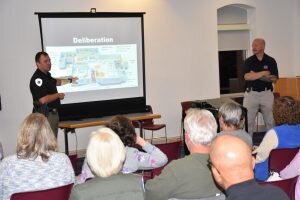By Greg Ellison
Staff Writer
(Oct. 24, 2019) Knowing whether fight or flight is the right response to an active shooter situation was the focus of a training class held by the Worcester County Sheriff’s Office last Thursday in Ocean Pines.
The Civilian Response to Active Shooter Events (CRASE) training class was hosted by Worcester County Commissioner Chip Bertino, with introductory remarks from Sen. Mary Beth Carozza (R-38) opening the hour-plus course at the Ocean Pines library.
Leading the presentation were sheriff’s office deputies Sgt. Mike Sand and Cpl. Josh Moore, who told participants that the key to successful training is repetition.
Using school fire drills as an example, Moore said school fire-related deaths are virtually unheard of, because of a half-century repetitive training.
“Unfortunately,” he said, referring to the growing number of active shooter drills, “this now is that new curriculum.”
The CRASE training class was created in 2004 at Texas State University and receives funding through the U.S. Department of Homeland Security.
The class espouses the “Avoid, Deny, Defend,” response model, which Moore said is comparable to the, “Run, Hide, Fight,” approach.
“The one unifying characteristic in every attack is a place where there were people,” he said.
Despite the “active shooter” label, Moore said attacks on the public are not limited to firearms. Knives, explosives and vehicles also are employed, he said.
“The media absolutely loves the term active-shooter event,” he said. “Those of us who are in the business hate it.”
Methodology aside, the goal remains unchanged.
“It doesn’t matter the mechanism … any attempted mass murder is what we’re trying to avoid,” he said.
Adopting the proper measures continues to challenge law enforcement, with Moore noting attacker profiles cut across race, gender, age and religious divides.
“There’s absolutely no box that we can pen these people into,” he said.
Moore said one theme common among perpetuators of random violence is the perception of being aggrieved.
“These people have been slighted or wronged in some way and they’re using this event … to lash out as revenge and an opportunity to … gain attention,” he said.
Venturing into risk factors, Moore highlighted a history of or exposure to violence, as well as stalking behaviors.
“If you grew up in the last 40 years, you’ve been exposed to a lot of violence,” he said.
In addition to bloodshed on television and the silver screen, the popularity of first-person shooter video games have also become an issue, he said.
“I’m not going to tell you right now that videogames create killers, because that’s not true,” he said. “I will tell you videogames make more effective killers [and] it will desensitize you to violence.”
With players earning points for on-screen slaughters, Moore said violent videogames reinforce unsavory inclinations.
“It’s operant conditioning at its finest … we’re rewarding violent behavior,” he said. “Video games won’t cause people to kill, but if they have the inclination it will make it easier.”
Substance abuse and mental illness are commonly at the base of what fuels mass murderers, with Moore noting the latter has become a sort of catch-all diagnosis.
“If anyone in anyway is operating outside the norms of societal behavior, they must be mentally ill,” he said. “That’s true, some people are ill, and some other people are just plain evil. We don’t want to acknowledge that but there is straight evil in this world.”
Other risk factors include a history of suicidal behavior.
“Suicide is a homicide,” he said. “If they’re willing to kill themselves, they don’t really care much about you.”
Traditionally, when police have responded to crime scenes involving people who have targeted others for death, if law enforcement didn’t take out the perpetrator, death was typically self-inflicted, Moore said.
“The current trend is a lot of arrests [and] there people are getting taken into custody to be famous,” he said. “Now they realize if they’re going to get a trial, it’s going to be 24-hour media coverage.”
Sand stressed the importance of being aware of friends or family members who potentially feel aggrieved and might exhibit signs of snapping.
“There is something that is eating at them that is kind of that spark that pushes them over the edge to finally follow through with their act,” he said. “You may pick up on somebody you know.”
Negative family dynamics and feelings of isolation are other commonalities noted among mass murderers.
“Unfortunately, for the most part, law enforcement has to be reactive,” he said. “We get the 911 calls.”
Despite the attention-grabbing headlines when schools are targeted, the bulk of mass shooting incidents in recent years have occurred in public places, Moore said
“For the last 10 years, all we’ve heard about is school shootings,” he said. “The majority of these attacks … happen in places of commerce.”
With the average attack lasting seven minutes, including an average police response of three minutes and about four minutes to locate and subdue the attacker, Moore advised anyone confronted by gunfire to flee fast and far if possible.
If departing appears risky, Sand said the next option is building walls by placing physical objects to block the attacker, with the final eventuality being prepared to fight using any items that can be weaponized.
“Either you concede your fate, or you do something to change it,” he said.

Cpl. Josh Moore, left, and Sgt. Mike Sand with the Worcester County Sheriff’s Office lead a Civilian Response to Active Shooter Events (CRASE) training class hosted by County Commissioner Chip Bertino at the Ocean Pines library last Thursday.
